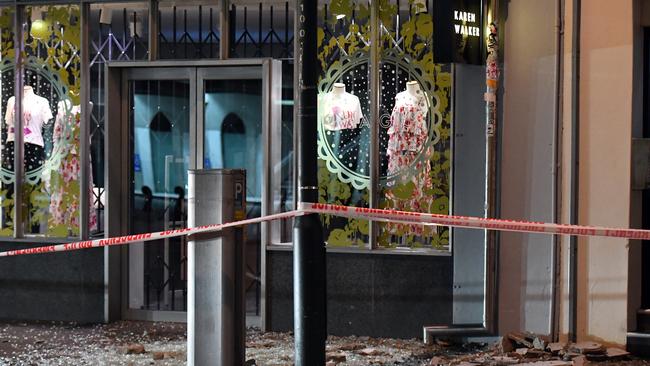New Zealand earthquake: Aftershocks and bad weather complicate recovery efforts
UPDATE: Australia has diverted HMAS Darwin to NZ’s Kaikoura coast to aid in earthquake recovery; will deploy its Seahawk for evacs, Sky News says.
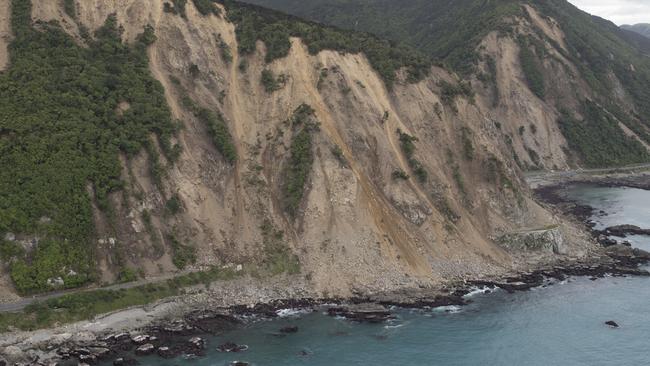
7.5 quake strikes rural area 15 kilometres deep
Trapped tourists flown to safety
Aftershocks continue to rattle country
- Two killed, 100-year-old woman rescued
- Why New Zealand is so vulnerable to earthquakes
UPDATE: Australia has diverted HMAS Darwin to NZ’s Kaikoura coast to aid in earthquake recovery; will deploy its Seahawk for evacs, Sky News says.
Earlier, a severe aftershock rocked central New Zealand, stopping trains and rattling MPs in the country’s parliament and further rattling the fraying nerves of tired residents across the Shaky Isles.
The aftershock was a magnitude 5.8 and is a brutal confirmation of what seismologists have been warning — that the country was in for weeks of aftershocks following Monday’s monster 7.5 quake.
Today’s monster aftershock was initially thought to be two separate quakes, but authorities believe it was just a single “severe” one of 5.9 magnitude at a depth of 20km at the top of the South Island, where the worst damage occurred in the 7.5 shake.
It was followed by a swarm of others, including one of magnitude 5.2. The aftershocks and the initial earthquake were so severe they were felt widely around the country.
There have been more than 1000 aftershocks since Monday morning. Hundreds continue to rock the Shaky Isles.
The recovery effort in New Zealand is being hampered by constant strong aftershocks and a vicious storm that has whipped up gales and heavy rain.
The capital city of Wellington, which was also hard by the quake, has now been almost completely cut off by the wild weather. Now trains have been suspended there after the latest aftershocks.
They hit as New Zealand Finance Minister Bill English was answering a question in the House of Representatives about the cost of the recovery — expected to run into the billions of dollars.
As he spoke buildings around the parliament rattled.
Earlier on Tuesday, there was some good news for people concerned about the fate of three cows who became viral stars when images of them perched on an “island” were beamed around the world.
The two adults and calf were left standing perched on a small part of land after their paddock was destroyed by the severe shake and landslides on a farm just outside Kaikoura, one of the worst hit towns.
International media, already reporting on the New Zealand quake, seemed captivated by the cows plight with the UK’s independent asking if they were the “luckiest cows in the world”.
Despite the huge concern for the cows, police said their priority was “to make sure all human lives are safe”. However, by mid-Tuesday morning it emerged farmers had dug a trench to free them, Newshub reported.
Meanwhile, a clearer picture of the damage caused by the earthquake is starting to become clear. In the North Canterbury town of Waiau at least 15 homes are damaged beyond repair. The town has now been cut off from the outside world for 36 hours.
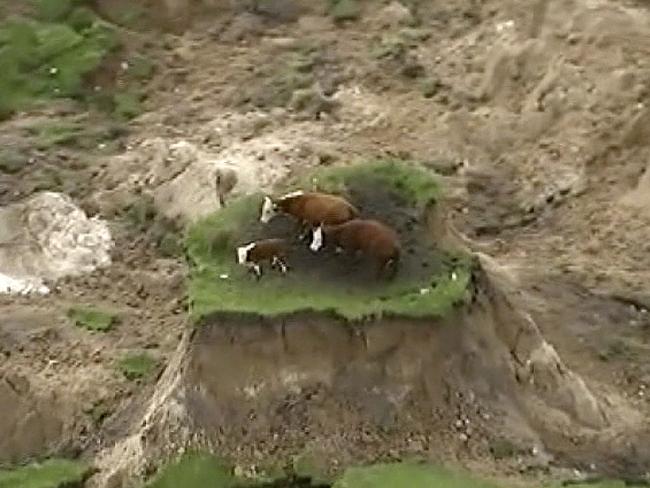
EVACUATIONS
The New Zealand military has stepped in to rescue tourists and locals trapped in the South Island town of Kaikoura, with all roads in and out cut off by massive landslides.
The air force lifted tourists out by helicopter and the Defence Force has sent a ship loaded with supplies from Auckland to distribute emergency aid. People will board and be dropped off in the Christchurch port of Lyttleton amid reports the town’s water supply could run low.
Sixteen flights are planned today, with four already having left early on Tuesday morning. Red Cross is rganising a system to prioritise the needs of elderly, pregnant woman and those with children, 1 News reported.
About 1200 tourists are estimated to be stranded. Another 2000 people live in the coastal town that is popular for watching whales and dolphins.
Air Commodore Darryn Webb, the Acting Commander Joint Forces New Zealand, said: “From all directions, Kaikoura has essentially been isolated.”
“It is clear from the photos taken by our personnel that the major route from Christchurch to Kaikoura is impassable.”
“So is the road from Kaikoura to Hanmer Springs and the one from Blenheim to Kaikoura.”
The massive 7.5 magnitude earthquake struck New Zealand just after midnight local time, killing two people and causing enormous landslides which have blocked tunnels and roads.
By this morning there had already been almost 900 aftershocks.
The big quake created a huge dam in the South Island’s Clarence River where the flow was blocked by debris, leading to a wall of water which broke through in a large wave around 4:20pm Monday.
Marlborough Borough Council residents urged to move to higher ground while 16 rafters who were on the river at the time were found by police.
In Kaikoura, around 600 people will spend the night in a local Marae, a traditional Maori meeting house.
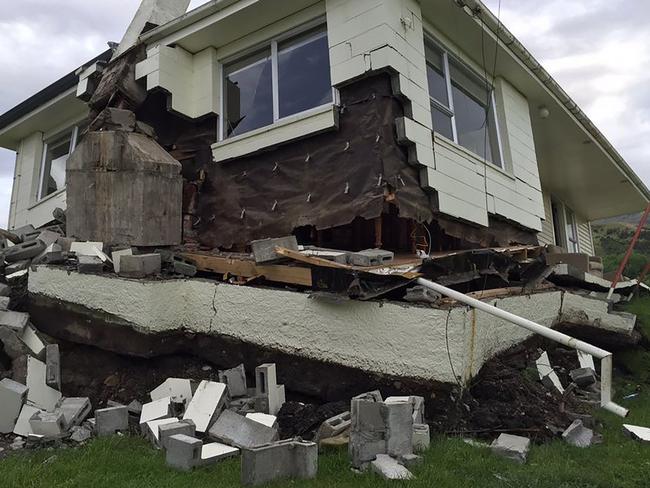
Commanding Officer of HMNZS Canterbury, Simon Rooke chats with us before the ship departs tonight for Kaikoura âš“ï¸// #eqnz #earthquake pic.twitter.com/jZ6Qm19VIz
— NZ Defence Force (@NZDefenceForce) November 14, 2016
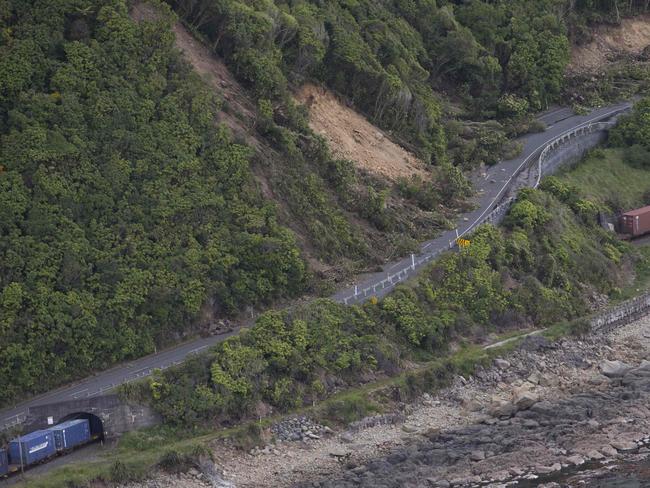
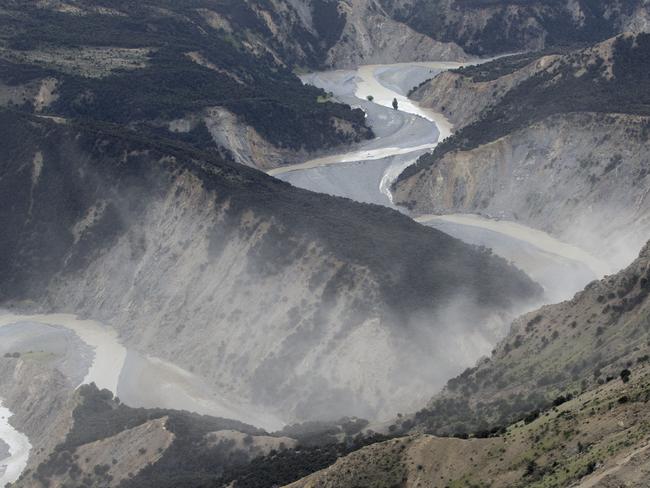
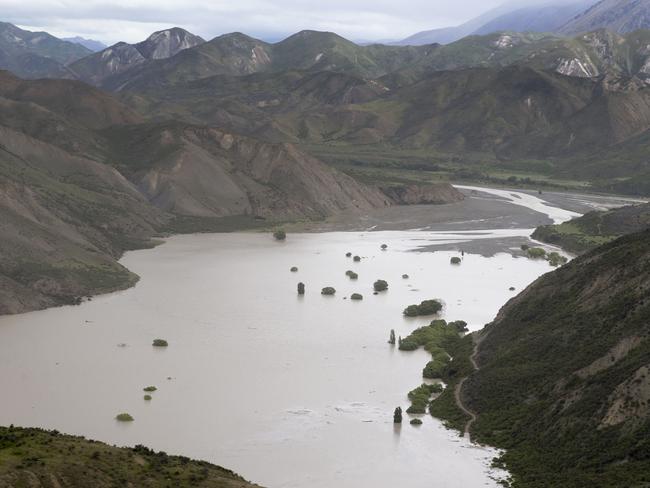
FAMILY HOMES RANSACKED
There have been at least three acts of looting from victims of Monday’s destructive New Zealand earthquake, including from the family of a disabled girl.
Police in Christchurch confirmed they had three reports of burglaries from homes where residents evacuated after being warned of a possible tsunami.
The tsunami warning for the entire east coast of New Zealand was cancelled earlier today and thousands of residents returned home, but The Civil Defense Agency later warned on its Facebook page that coastal areas could witness strong tidal currents and sea level fluctuations for hours.
Three families found their homes ransacked, Canterbury District Commander Superintendent John Price said.
One of those were Melissa and Matt Mill, whose youngest daughter has muscular dystrophy. The couple lost a work truck and $5000 hearing device relied upon by their 12-year-old daughter, along with items like their television and an Xbox.
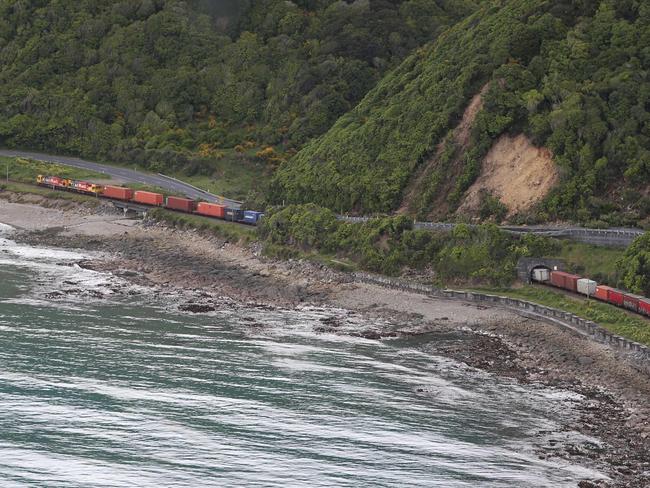
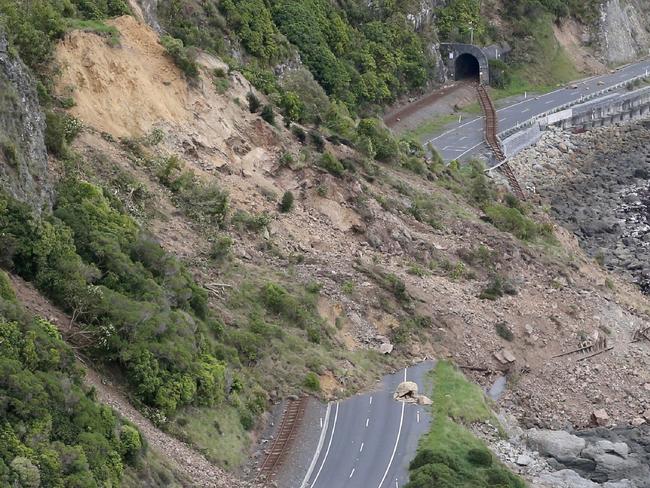
The powerful quakekilled two people and was felt across much of the country just after midnight local time, causing widespread panic, power outages and a small tsunami.
It struck near Hanmer Springs, 91km north of Christchurch, which is still recovering after being devastated by an earthquake in 2011.
More than 400 aftershocks have been recorded, as New Zealand continues to shake, including four over magnitude 6.0 Scientists have said they could last several months.
One strong aftershock, at 11.30am [Australian eastern time], registered as a “severe” 6.3 magnitude aftershock.
Officials from Geonet, the domestic natural hazards agency, have said one thing can be said “with certainty” — there will be more earthquakes to come in the affected area.
Geonet public information manager Sara McBride said the destructive earthquake was two separate but related events, that lasted a staggering two minutes.
“Our reports indicate that the combination of these two quakes lasted two minutes, with the most severe shaking at around 50 seconds. It was widely felt throughout both the North and South Islands. It looks like one was a strike-slip and the other was a thrust fault.”
There was a 12 per cent chance of a quake higher than a magnitude 7 happening in the 24 hours after the initial quake.
A tsunami — with waves reportedly as high as two metres — struck the northeastern South Island coast around the city of Kaikoura, 183km north of Christchurch, while smaller waves were recorded in the capital city Wellington, at the southern tip of the North Island, and locations along the east coast. No significant damage or injuries resulting from the tsunami have been reported.
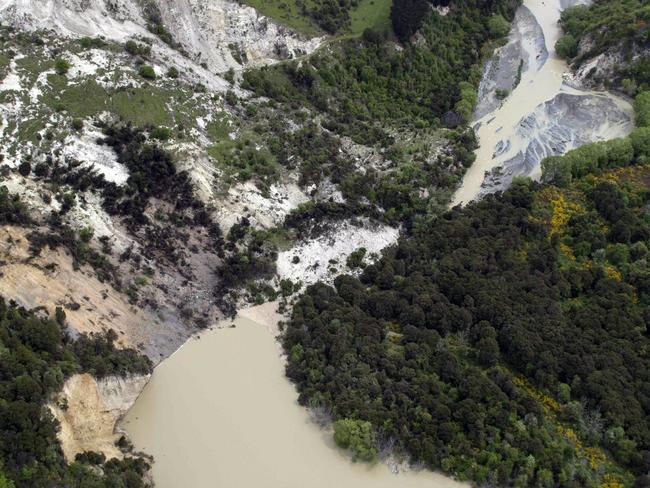
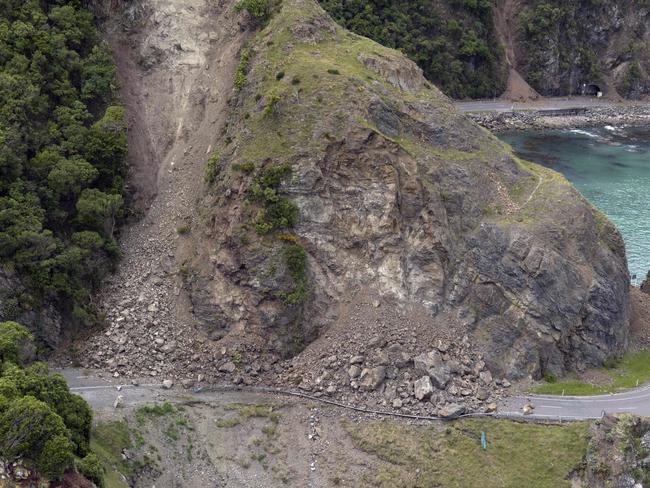
Last 48 hours in NZ in 30 seconds. #eqnz
— Harkanwal (@kamal_hothi) November 13, 2016
All quakes above magnitude of 2.
Source: https://t.co/p9CvaAHuK3 pic.twitter.com/6SuProXUue
TWO CONFIRMED DEATHS
Police confirmed one death at the Elms Homestead in Kaikoura, where three people live. One person was able to escape, one was rescued and third was killed.
A doctor involved in the frantic search through the rubble, Chris Henry, told Stuff the home “collapsed like a pack of cards”. A digger was used to help remove the trapped people. Two women were pulled out of the ruins by the fire service.
“The first lady actually got out pretty easily and the second lady was trapped for awhile,” Dr Henry said.
One of the rescued women was reportedly 100-years-old. The victim is believed to be the elderly woman’s son. The other woman was the victim’s wife.
The second death is thought to have happened on a remote property about 150km north of Christchurch. That person reportedly died from a heart attack.
Civil Defence, which handles the response to internal emergencies, had been told a truckie was missing, leading to fears he was buried under tonnes of earth that has covered a major highway near Kaikoura. However, he has been found alive this afternoon between two big slips.
There were power outages in both the North and South Islands and mobile phone networks struggled to keep up with demand as panicked people tried to get in touch with loved ones.
New Zealand Prime Minister John Key told reporters early on Monday there had been two deaths. More couldn’t be ruled out as authorities reached isolated communities near the epicentre.
Mr Key praised the response to the disaster and tsunami warnings.
“New Zealanders responded as they should have. They took the (Civil Defence) advice seriously,” he said. He and acting Civil Defence Minister Gerry Brownlee have flown on a military helicopter to inspect the damage.
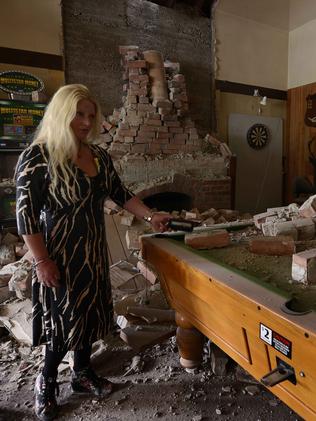
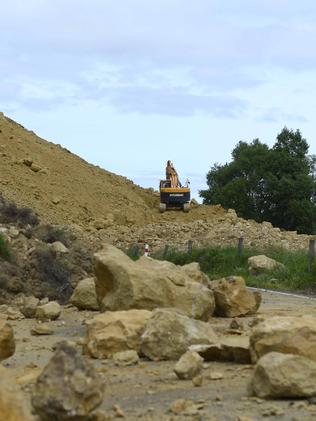
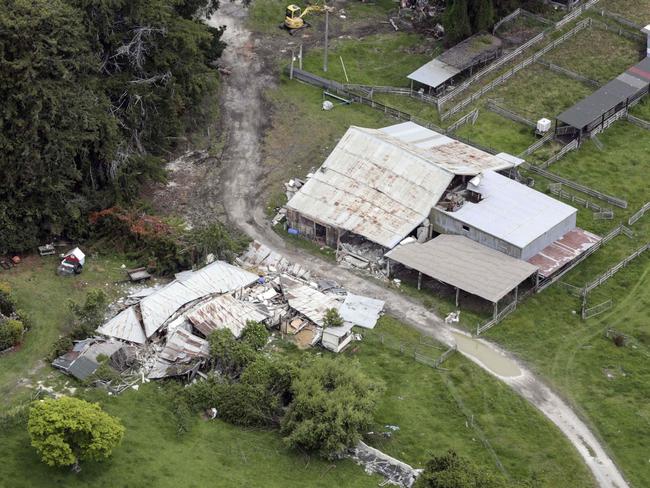
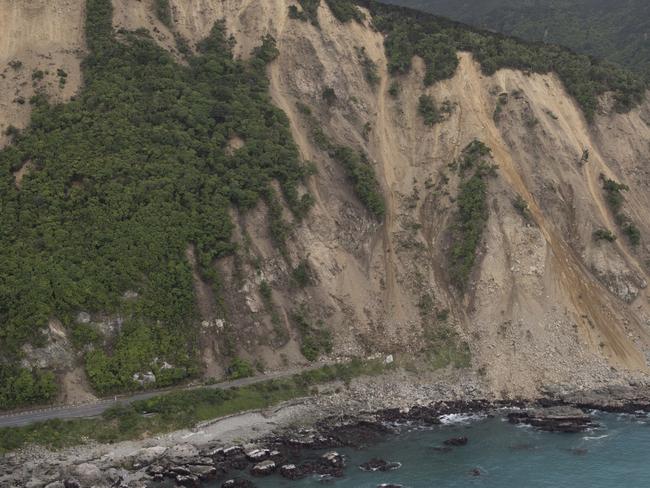
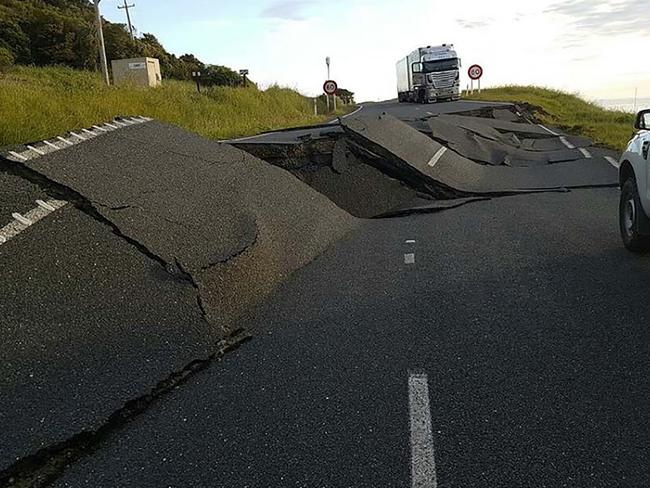
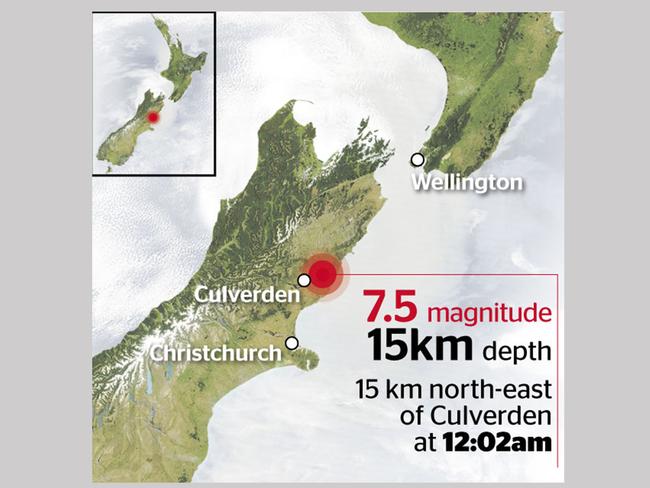
The Canterbury District Health Board have confirmed that three people have been treated in the Christchurch Hospital emergency department with earthquake-related injuries. They were a male in his late 50s from Kaikoura, a female in early 50s from Kaikoura and male in early 60s from North Canterbury. All are in a stable condition.
Some homes close to the epicentre are reportedly unliveable. Major highways have been blocked essentially cutting Kaikoura off.
A house at Bluff Station btw Blenheim & Kaikoura. Right on the Kekerengu fault line. Sue Murray says Simon, a farm worker was in the house pic.twitter.com/n1gxBJqX8s
— Alex Perrottet (@alexperro) November 13, 2016
Wow....the land is screwed. There must have been significant stock losses. 😢 #nzearthquake #nzquake #eqnz pic.twitter.com/bmqS89NAaS
— JuanitaNZ (@Signsoflife27) November 14, 2016
‘I THOUGHT I WAS GOING TO DIE’
TsunJeck Lim, 26, was shaken awake on the 10th floor of a central Wellington apartment building. Water poured from the roof as pipes burst. His furniture and possessions were strewn across the apartment.
“I thought I was going to die,” he told the The New Zealand Herald.
“Things started shaking and then things started falling one by one. I thought the building was going to collapse, but it stopped and I just ran down the stairs.”
He returned inside at 5am, and was shocked by the scale of the damage. Photos show his whole apartment in disarray, with furniture and possessions strewn everywhere.
He was later seeking shelter at an office nearby.
“I am still terrified. I haven’t slept all night.”
Photos from Oaro, Kaikoura show the force of the #eqnz @nzherald pic.twitter.com/iaZihnweCw
— Morgan Tait (@morgtait) November 13, 2016
Wow, @stuartsmithmp #eqnz pic.twitter.com/hZ9kpQjIX0
— Megan Campbell (@MeganCampbellNZ) November 13, 2016
Ron in Sydenham, Christchurch, described the shaking as “like being on a ship”.
It was a very massive earthquake. Everything that’s hanging is continually shaking like we’re on the harbour, on the lake.”
Tess Prentice was thrown out of her bed in her North Canterbury clifftop family home and she thought it was the “end of the world”. Huddling with her parents, Dr Anthea and Snip Prentice, she began to sob as the violent tremors rolled on and on.
“It was like someone picked up the house and started shaking us,” Anthea told the Herald. They ended up running onto the lawn.
By the time the shaking was over their North Canterbury house had been ruined. Its exterior and interior is both cracked and gaping. The chimney collapsed, with a gaping hole in the roof. Shelves have been emptied.
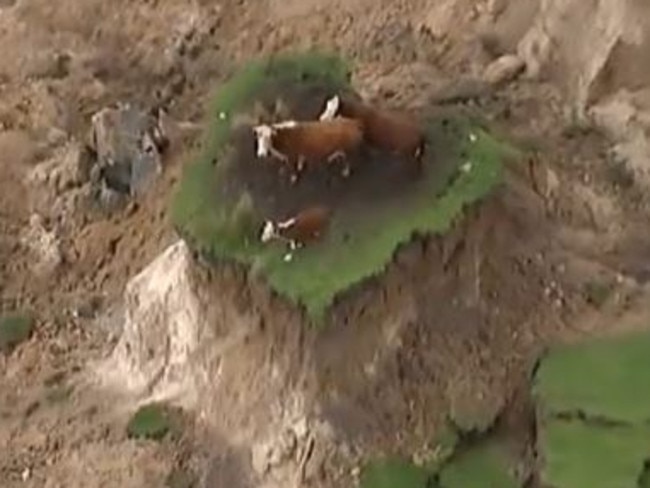
“All our treasures ... things we have inherited from our parents ... stuff you can’t really replace,” says Anthea.
But the Prentices knew they were lucky to not have rolled down the cliff into the Pacific.
“Plenty of people over the years have said, ‘Oh that’s close to the edge ...’ but I’ve always felt quite safe here,” Anthea said.
Newstalk ZB host Chris Lynch, who lives on the top floor of an apartment complex in central Christchurch, said the quake was like nothing he’d ever experienced.
“In terms of the motion of the quake ... You felt off balance no matter what you tried to do or where you tried to escape.
“The sheer rolling motions ... I really thought it wasn’t going to end.”
Mr Lynch said the motions of the quake made it particularly frightening.
“You get used to aftershocks, you just swear and laugh at them then go about your daily life.
“This one was frightening, in fact it wasn’t shaking just going up or down, it was all over the show like you were the tennis ball in the juggler’s arm.”
June in Martinborough in the Wairarapa said she felt shaking then rolling.
“I live in a 90-year-old house. I’ve got a lot of things hanging up like wind chimes. They were swaying back and forth by at least a foot.
“I was crouched with the dogs under the door. I felt seasick.”
Geonet confirmed the magnitude as 7.8 after initially reporting it as 6.6.
SCHOOLS ASKED TO STAY CLOSED
Schools from North Canterbury to Wellington have been asked to stay closed until they can be checked for damage.
The Wellington CBD resembles a ghost town today with many workers staying away from the downtown area while streets are cleared of debris and buildings are checked. The central city sustained minor damage in a series of smaller quakes in 2013.
Residents rushed to the hills that ring the city early Monday when the tsunami alert was issued. Many said on social media they were reluctant to return to sea level after the fright.
Kaikoura and several small South Island towns have been left isolated, with water and sewerage systems down and roads and rail lines blocked, as aftershocks and landslides continue.
Power was cut to many towns and cities in the upper South Island lower North Island, but is slowly being restored. The worst affected may still be without power into Tuesday.
The cost of the earthquake is expected to run into billions of dollars.
Seismologist Caroline Little told Newshub the earthquake had “30 times” more energy than the February 2011 one, but the energy release was spread over a much wider area.
Prime Minister Malcolm Turnbull told Sunrise he had spoken with Mr Key.
“I assured him of absolute solidarity and support from Australia. John appreciated that. He knows that we support them when it comes to emergencies and natural disasters.”
He said he passed on Australian condolences for the two people killed.
“But obviously, it is early days. He is a great leader. New Zealand is very experienced with dealing with earthquakes, and I am sure he will have the matter in hand.”
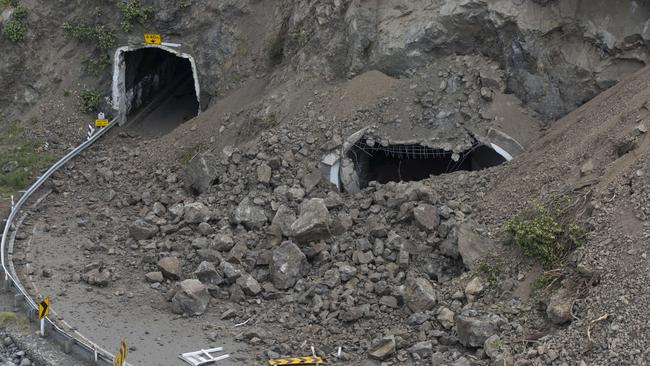
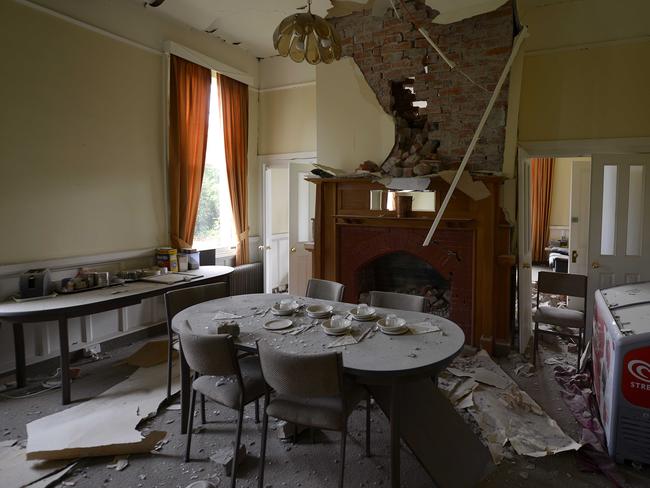
The quake temporarily knocked out New Zealand’s emergency call number, 111, police reported.
Near the epicentre, it opened up snaking fissures in roads and triggered landslides. In Wellington, it collapsed a ferry loading ramp, broke windows and caused items to fall from shelves. It also forced hundreds of tourists onto the streets as hotels were evacuated.
Authorities in Wellington were urging people who work in the centre of the city to stay home today. City officials said some large buildings were showing signs of structural stress, and that the quake would likely have caused a mess in some buildings. The city’s suburban rail network was shut while crews checked tracks, bridges and tunnels.
High winds and rain was forecast to hit affected areas tonight which is expected to complicate the recovery effort. the winds, which could reach speeds higher than 100km/h, have the potential to further destabilise damaged buildings.
Those caught up in the quake said they feared for their lives. Pam Bennett from Amberley told TVNZ the quake was the worst she’d ever felt.
“It was like my house was on a bungee cord — boom, boom, boom, backwards and forwards. I just couldn’t stand up no matter what,” she said.
Anna Harcourt told the Herald Sun: “I was asleep and all off a sudden I was woken to my bedroom shaking. It just went on and on and there was a moment when I genuinely thought that this was it, that my life was going to end.”
Ms Harcourt said she ran out of her bedroom and hid for cover under a table.
“As soon as the trembling stopped my boyfriend and I ran outside and saw heaps of people and families gathered together,” she said. “Everyone is in complete shock … it’s terrifying.”
There were reports that houses in Cheviot, near where the quake was centred in Canterbury, were badly affected by the shake.
Photos and videos posted to social media showed shelves overturned inside homes, wine bottles smashed on the ground of stores and people out on the street following the initial quake.
The earthquake is the third over 7 magnitude since 2009 to shake the South Island. Scientists told New Zealand media while that was “unusual” it was within expectations in a historical context.
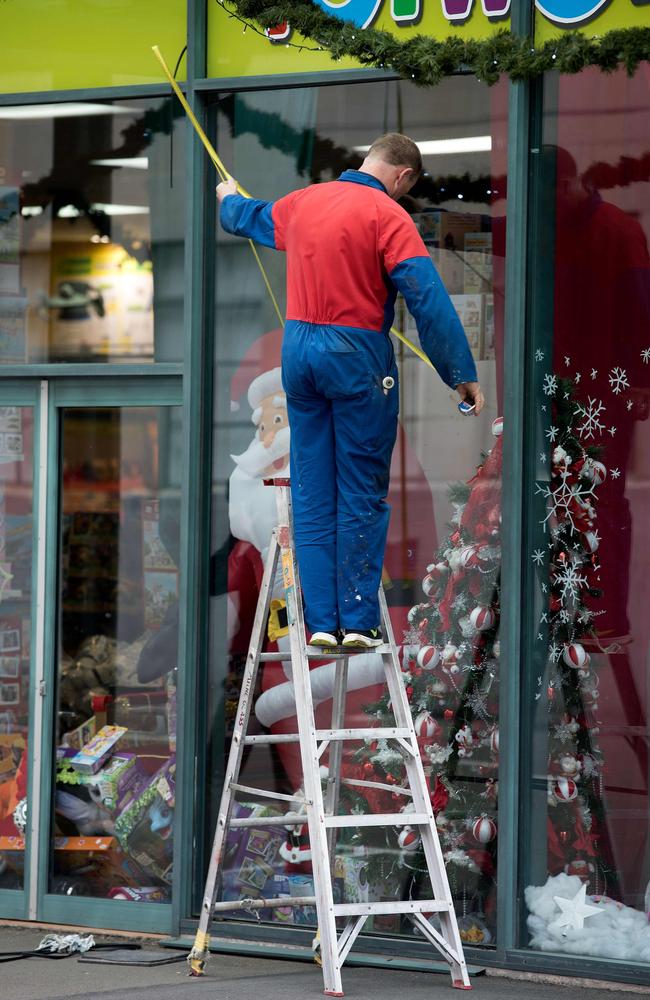
THE SHAKY ISLES
The earthquake was less devastating than the 2011 quake in nearby Christchurch, which left 185 dead due to the shallow epicentre close to the city centre.
In contrast, Monday’s quake was centred in a rural area around halfway between Christchurch and Wellington.
Seismologists said the 2011 disaster also had more powerful high-frequency energy, lasting barely 10 seconds, while today’s quake, despite having a higher magnitude, was deeper and of a lower frequency.
This saw the energy released more slowly over a longer period — up to two minutes — as it travelled in a “rolling” motion along an estimated 200 kilometre fault line.
How does NZ cope with so many quakes?
New Zealand has strict building compliance codes that aim to limit quake damage and keep casualties to a minimum.
Modern buildings such as “The Beehive” parliamentary complex in Wellington have complex foundation systems incorporating huge rubber blocks that allow it to shake without sustaining structural damage.
Residential houses are generally built of timber, which flexes and bends in a quake, rather than collapsing like masonry.
The system failed in the 2011 Christchurch quake simply because the fault line which caused the tremor was unknown before it ruptured, so authorities thought the city was relatively stable and did not impose the strict conditions used elsewhere.
Can New Zealand expect ‘the big one’?
New Zealand sits on the boundary of the Australian and Pacific tectonic plates, which form part of the so-called “Ring of Fire”, and experiences up to 15,000 tremors a year.
The most powerful to date was the 8.2-magnitude disaster in Wellington in 1855 that caused four deaths and changed the city’s entire geography, pushing the shoreline out 200 metres as it thrust the harbour floor upwards.
New Zealand’s government-run GNS Science says on its website that the Alpine Fault, which runs for about 600 kilometres up the spine of the South Island, has a high probability of rupturing in the next 50 years.
This will produce one of the biggest earthquakes since European settlement. It has only ruptured four times in the past 900 years, each time producing an earthquake of about magnitude 8.0. — from AFP.

